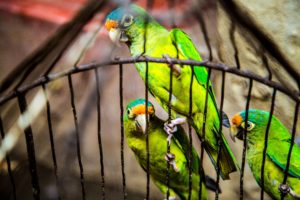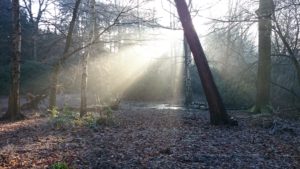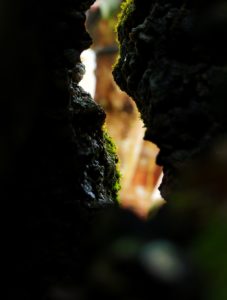“Feathered Things” and “Long-ago Places”: Motivic Morrison

The Secret of Empty Places. johndavidmann.com
Sets of related images, sprinkled across Toni Morrison’s trilogy, create a rhythmic experience for readers.
Certain types of images are repeated within a novel, and across all three of the trilogy novels. What are some of these, and how might readers experience their reoccurrence in different contexts? Why is this repetition such a significant feature of Morrison’s use of sensual, concrete imagery?
Motivic Variations in Morrison’s Descriptive Details
Readers will see a thing again, and again. Or feel and hear it, as in wings beating, which we can find in all three novels (B, J, & P). I covered “motivic variation” in other blogpieces, but essentially it is a form of repetition with variance, or difference. Morrison’s imagery is rich in motivic variation.
So Morrison combines the qualities of seeing the thing directly and seeing it repeatedly with variations—and we have some powerful, almost un-paraphrasable pictures in our mind’s eye. Let’s now see if that works with some examples. I’ve selected two image-funds, but there are many more, so many that you can do what I do below very readily with your readings of the novels (see the Response Invitations below).
Wings, Feathers Birds
When in Beloved, Sethe saw the “Four Horsemen” come (3 from the plantation in Kentucky she recognized and a Sheriff from Cincinnati) to take her and her 4 children back into slavery (the Fugitive Slave Law made legal the transportation of runaway slaves from free states back to the South), “she heard wings. Little hummingbirds stuck their needs beaks right through her head cloth into her hair and beat their wings . . . . Simple. She just flew” (Beloved 192 emphasis added).

Hermes Rivera /Unsplash
In Jazz, the first sentence introduces Violet as that woman who “used to live with a flock of birds on Lenox Avenue” (3). Birds become a motivic improvisation or variation connecting parts of the narrative together. Joe Trace, for instance, “is married to a woman who speaks mainly to her birds. One of whom answers back: ‘I love you’” (23). These last words of the first section not only recall its opening page but also anticipate the beginning of the next section: “Or used to. When Violet threw out the birds, it left her not only without the canaries’ company and the parrot’s confession but also minus the routine of covering their cages . . .” (27). The first and second sections are separated by two fully blank pages—an interval—making the “or used to” emphatic. The motif of Violet’s birds is also repeated later in the novel when Violet gets a new bird “cheap” because it “hardly had any peck to it” (224), and she and Joe took it up on the roof to listen to jazz, which cured it (224).

Lakeisha Bennett /Unsplash
In Paradise, Consolata first sees Deacon Morgan, the man who will become her lover, on his horse as she is waiting for Mary Magna to finish her business in Ruby’s drugstore. “Sha sha sha. Consolata saw his profile, and the wing of a feathered thing, undead, fluttered in her stomach” (226). For two months, until she saw him again, “time [was] made unstable by a feathered thing fighting for wingspread” (227).
Responses Invitation: reflect, write, post:
Are you struck by these connection between the feathered, winged things in Beloved and Paradise? What do they suggest, and why not state directly the emotions that Sethe and Consolata are experiencing?
And those caged parrots in Jazz, whom Violet set loose to “freeze or fly”? Then replaced later by a sickly parakeet nursed back to health through music? What do you think about them?
Empty places, long ago spaces
Toni Morrison acknowledges in several essays and interviews that remembering the long-ago lives of people under slavery and their descendants like she does in her work is part cultural/family legacy, part creative imagination. In her essay, “Rememory,” furthermore, she describes the poignant nostalgia that the “re-membering” process produces. That nostalgia comes to life in the pages of the Beloved trilogy, most dramatically so in those hauntingly empty spaces and long-ago places: “the Clearing” in Beloved, the Wild’s deserted cave in Jazz, and the burned-out house in Paradise.

Martin Murphy /Unsplash
Sethe goes to the place where her mother-in-law, Baby Suggs, used to preach to the people: a clearing in the woods where these former and runaway slaves would gather and dance and sing. She wanted “to listen to the spaces that long-ago singing left behind” (Beloved PG). The past is evoked as living ahead into the present. This is a helpful concept, because the losses in that Clearing, now that nobody goes there collectively anymore by the 1870’s, are still palpable, and Sethe wants to be in them, a rememory, a nostalgic bathing of sorts.
In the rural-Virginia chronotope of Morrison’s Jazz, Joe Trace tracks his alleged mother, the woman named Wild, to a cave in the mountains where there are signs indicating her presence, but Joe never actually meets up with her on his 3 attempts to track her. Later, through the narrator’s visualization, we readers encounter Wild’s cave again; this time, with traces of Golden Gray’s things—hairbrush, clothing—there, suggesting that Golden Gray and Wild are together, disappeared from the narrative, but their rememory is almost pulsing in that Cave, where the likes of Golden Gray’s blond curls might mingle with Wild’s “skein of black wool” (Jazz 167).

Romio Joseph /Unsplash
This “home in the rock,” Morrison writes (Jazz 221), which gives the narrator of Jazz a near-religious view of Wild’s cave. But while religion—early Christian-era gnosticism, 20th century African-American theology, and “Genesis Time”—is developed more centrally into the story structure in Paradise than in either Beloved or Jazz, its signature empty space, long-ago place is contrary: a burned-out house where Consolata and Deek go to have their erotic assignations. Consolata see strange shapes on the house’s walls: a girl with butterfly wings, a man pointing away from the house with a harsh expression (Paradise PG).
In each of the three novels, the “empty” spaces are specialized chronotopes: while they are described with suggestive visual details and have information about where they are located and when something happened there, they also signify something evanescent or unknowable. We readers are not supposed to be able to figure out these spaces completely. They must remain unfinished descriptions, so that readers may enter, once again and again and yet again, into the” making of the story.”
Description is vital to Morrison’s representation of the African American Diaspora, which will be read through material sites, those long-ago geographic spaces that still shimmer in our mind’s eye. From plantations, slave quarters, trees; through jazz clubs, rivers, caves; and on unto the prairies, Convents, and all-black towns: Morrison has given us descriptive “rememories” to help us to “enunciate race” without its “lethal cling.”
Responses Invitation: reflect, write, post
What do you think about Morrison’s use of description? You can address the imagery I’ve cited above (wings, feathers, birds; empty places, long-ago spaces), or bring your own examples to the blog for generous reception and discussion!
This ends the cluster on Aesthetics for now. How about going to my next suggested cluster on Morrison’s Intertextuality? The introductory blog here is Intertextuality: a Call-Response Modality.
